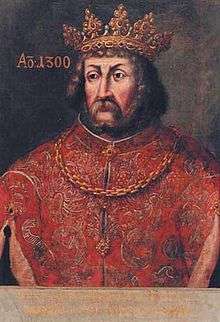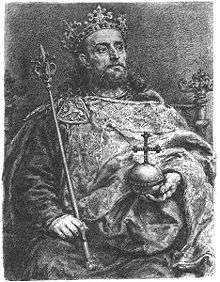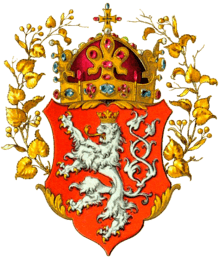Wenceslaus II of Bohemia
| Wenceslaus II | |
|---|---|
 Wenceslaus II in 1300 | |
| King of Bohemia | |
| Reign | 1278–1305 |
| Coronation | 2 June 1297, Prague[1] |
| Predecessor | Ottokar II |
| Successor | Wenceslaus III |
| King of Poland | |
| Reign | 1300–1305 |
| Coronation | 25 July 1300, Gniezno |
| Predecessor | Przemysl II |
| Successor | Wenceslaus III |
| Born |
27 September 1271 Prague, Bohemia |
| Died |
21 June 1305 (aged 33) Prague, Bohemia |
| Spouse |
Judith of Habsburg Elisabeth Richeza of Poland |
| Issue |
Wenceslaus III Anne, Queen of Bohemia Elisabeth, Queen of Bohemia Margaret, Duchess of Wroclaw Agnes, Duchess of Jawor |
| House | Přemyslid dynasty |
| Father | Ottokar II of Bohemia |
| Mother | Kunigunda of Slavonia |
Wenceslaus II Přemyslid (Czech: Václav II.; Polish: Wacław II Czeski; 27 September[2] 1271 – 21 June 1305) was King of Bohemia (1278–1305), Duke of Cracow (1291–1305), and King of Poland (1300–1305).
He was the only son of King Ottokar II of Bohemia and Ottokar's second wife Kunigunda. He was born in 1271, ten years after the marriage of his parents. Kunigunda was the daughter of Rostislav Mikhailovich, lord of Slavonia, son of a Grand Prince of Kiev, and Anna of Hungary, daughter of Béla IV of Hungary. His great-grandfather was the German king Philip of Swabia. Wenceslaus II was the grandfather of the Holy Roman Emperor, Charles IV. He was a member of the Přemyslid dynasty.
Early years
In 1276 Rudolf I, King of the Romans, placed Ottokar under the ban of the empire and besieged Vienna. This compelled Ottokar in November 1276 to sign a new treaty by which he gave up all claims to Austria and the neighbouring duchies, retaining for himself only Bohemia and Moravia. Ottokar's son Wenceslaus was also betrothed to Rudolph's daughter Judith. It was an uneasy peace. Wenceslaus's father died on 26 August 1278 in the Battle on the Marchfeld shortly before Wenceslaus' seventh birthday.
Before Wenceslaus became of age, the government was handled by Otto V, Margrave of Brandenburg, who is said to have held Wenceslaus captive in several locations. He returned to Bohemia in 1283, at the age of twelve. His mother's second husband, Záviš of Falkenštejn, ruled instead of him for a few years.
On 24 January 1285, Wenceslaus married Judith of Habsburg, daughter of Rudolf I, to whom he had been betrothed since 1276. In 1290, Wenceslaus had Záviš beheaded for alleged treason and began ruling independently.
King of Bohemia and Poland

In 1291, Przemysł II, High Duke of Poland, ceded the sovereign Duchy of Kraków to Wenceslaus. Kraków was associated with the overlordship of Poland, but Przemysł held the other duchies and in 1295 was crowned King of Poland. After Przemysł's death in 1296, Wenceslaus became overlord of Poland and in 1300, he was crowned King of Poland.[3]
Silver in Kutná Hora
In 1298, silver was discovered at Kutná Hora in Central Bohemia. Wenceslaus took control of the mine by making silver production a royal monopoly and issued the Prague groschen, which became the most popular of the early Groschen-type coins. Kutná Hora was one of the richest European silver strikes ever: between 1300 and 1340 the mine may have produced as much as 20 tons of silver a year.
In 1300, Wenceslaus issued the new royal mining code Ius regale montanorum. This was a legal document that specified all administrative as well as technical terms and conditions necessary for the operation of mines.[4]
The Crown of Hungary and death

Queen Judith died in 1297. Wenceslaus' second wife was Elisabeth Richeza, daughter of Przemysł II, King of Poland (1295–1296). Later she remarried to Rudolph of Habsburg, duke of Austria, who also became king of Bohemia for a brief period in those unruly years.
In 1301, Wenceslaus' kinsman Andrew III of Hungary died and the Árpád dynasty became extinct in the male line. Wenceslaus was one of the relatives who claimed the throne, and he accepted it from a party of Hungarians on behalf of his young son, betrothed to Andrew's only child, Elizabeth. On 27 August 1301, his son was crowned in Székesfehérvár as King of Hungary under the name Ladislaus V (Hungarian: László,[5] Czech, Slovak and Croatian: Ladislav).
At that time the Kingdom of Hungary was split into several de facto principalities, and young Wenceslaus was only accepted as the King of Hungary by the rulers in modern Slovakia (Matthew III Csák), in Burgenland (the Güssings [Kőszegis]) and on territory around the capital, Buda. But the Abas and Matthew Csák switched sides in 1303 and started to support Wenceslaus' rival Charles Robert of Anjou. Consequently, the young Wenceslaus, in Ofen (Buda), became afraid and wrote to his father in Prague for help. His father took a large army and invaded Buda, but having considered the situation, he took his son and the Hungarian crown and returned to Bohemia (1304). Ivan of Güssing was named to represent Wenceslaus III in Hungary.
Wenceslaus II died in 1305, at the age of 33, probably of tuberculosis. He was succeeded by his son, Wenceslaus III (Václav III.), the last of the Přemyslid kings in the male line.
Review of government of Wenceslaus II
Wenceslaus II is considered as one of the most important Czech Kings. He built a great empire stretching from the Baltic Sea to the Danube river and established numerous cities, such as Plzeň in 1295. He won for his family three royal crowns (Bohemia, Hungary and Poland). The Kingdom of Bohemia was the largest producer of silver in Europe in his time. He created the penny of Prague, which was an important European currency for centuries.
During his reign, there was great urban development. He planned to build the first university in Central Europe. The power and wealth of the Kingdom of Bohemia gave rise to great respect, but also to the hostility of European royal families. His son King Wenceslaus III was unable to maintain a mighty empire, and soon after the untimely death of Wenceslaus II, his empire began to crumble.[6]
Family
He was married twice:[3]
In 1285 in Eger (Cheb), he married Judith of Habsburg (1271–1297), daughter of Rudolph I of Germany and his wife Gertrude of Hohenburg. She died shortly after their 10th child was born:
- Přemysl Otakar (6 May 1288 – 19 November 1288).
- Wenceslaus III (6 October 1289 – 4 August 1306); King of Bohemia, King of Hungary and King of Poland.
- Agnes (6 October 1289 – soon after 6 August 1296), twin of Wenceslaus; married in 1296 to Rupert, eldest surviving son of German King Adolf of Nassau.[2]
- Anne (10 October 1290 – 3 September 1313), married in 1306 to Henry of Carinthia.
- Elisabeth (20 January 1292 – 28 September 1330), married in 1310 to John of Luxembourg.
- Guta (3 March 1293 – 3 August 1294).
- John (26 February 1294 – 1 March 1295).
- John (21 February 1295 – 6 December 1296).
- Margaret (21 February 1296 – 8 April 1322), married in 1308 to Bolesław III the Generous, Duke of Wrocław.
- Guta (born and died 21 May 1297).
In 1300, he married Elisabeth Richeza (1286–1335), daughter of Przemysł II. They had one child:
Wenceslaus has also numerous illegitimate children, including Jan Volek (?? – 27 September 1351), bishop of Olomouc
Ancestry
| Ancestors of Wenceslaus II of Bohemia | ||||||||||||||||||||||||||||||||||||||||||||||||||||||||||||||||||||||||||||||||||||||||||||||||||||||||||||||||||||||||||||||||||||||||||||||||||||||||||||||||||||||||||||||||||||||||||||||||||||||||||||||||||||||||||||||||||||||||||||||||||||||||||||||||||||||||||||||||||||||||||||||||||||||||||||||||||||||||||||||||||||||||||||||||||||||||||||||||||||||||||||||||||||||||||||||||||||||||||||||||||||||||||||||||||||||||||||||||||||||||||||||||||||||||||||||||||||||||||||||||||||||||||||||||||||||||||||||||||
|---|---|---|---|---|---|---|---|---|---|---|---|---|---|---|---|---|---|---|---|---|---|---|---|---|---|---|---|---|---|---|---|---|---|---|---|---|---|---|---|---|---|---|---|---|---|---|---|---|---|---|---|---|---|---|---|---|---|---|---|---|---|---|---|---|---|---|---|---|---|---|---|---|---|---|---|---|---|---|---|---|---|---|---|---|---|---|---|---|---|---|---|---|---|---|---|---|---|---|---|---|---|---|---|---|---|---|---|---|---|---|---|---|---|---|---|---|---|---|---|---|---|---|---|---|---|---|---|---|---|---|---|---|---|---|---|---|---|---|---|---|---|---|---|---|---|---|---|---|---|---|---|---|---|---|---|---|---|---|---|---|---|---|---|---|---|---|---|---|---|---|---|---|---|---|---|---|---|---|---|---|---|---|---|---|---|---|---|---|---|---|---|---|---|---|---|---|---|---|---|---|---|---|---|---|---|---|---|---|---|---|---|---|---|---|---|---|---|---|---|---|---|---|---|---|---|---|---|---|---|---|---|---|---|---|---|---|---|---|---|---|---|---|---|---|---|---|---|---|---|---|---|---|---|---|---|---|---|---|---|---|---|---|---|---|---|---|---|---|---|---|---|---|---|---|---|---|---|---|---|---|---|---|---|---|---|---|---|---|---|---|---|---|---|---|---|---|---|---|---|---|---|---|---|---|---|---|---|---|---|---|---|---|---|---|---|---|---|---|---|---|---|---|---|---|---|---|---|---|---|---|---|---|---|---|---|---|---|---|---|---|---|---|---|---|---|---|---|---|---|---|---|---|---|---|---|---|---|---|---|---|---|---|---|---|---|---|---|---|---|---|---|---|---|---|---|---|---|---|---|---|---|---|---|---|---|---|---|---|---|---|---|---|---|---|---|---|---|---|---|---|---|---|---|---|---|---|---|---|---|---|---|---|---|---|---|---|---|---|---|---|---|---|---|---|---|---|---|---|---|---|---|---|---|---|---|---|---|---|---|---|---|---|---|---|---|---|---|---|---|---|---|---|---|---|---|---|---|---|---|---|---|---|---|---|---|---|---|---|---|---|---|---|---|---|---|---|---|---|---|---|---|---|---|---|---|---|---|---|---|---|---|---|---|---|---|---|---|---|---|---|---|---|---|---|---|---|---|---|---|---|---|---|---|---|
| ||||||||||||||||||||||||||||||||||||||||||||||||||||||||||||||||||||||||||||||||||||||||||||||||||||||||||||||||||||||||||||||||||||||||||||||||||||||||||||||||||||||||||||||||||||||||||||||||||||||||||||||||||||||||||||||||||||||||||||||||||||||||||||||||||||||||||||||||||||||||||||||||||||||||||||||||||||||||||||||||||||||||||||||||||||||||||||||||||||||||||||||||||||||||||||||||||||||||||||||||||||||||||||||||||||||||||||||||||||||||||||||||||||||||||||||||||||||||||||||||||||||||||||||||||||||||||||||||||
| Wikimedia Commons has media related to Wenceslaus II of Poland and Bohemia. |
References
- ↑ "The Royal Route". Královská cesta. Retrieved 11 July 2013.
- 1 2 K. Charvátová, Václav II. Král český a polský, Prague 2007, p. 18.
- 1 2 Cawley, Charles, Profile of Wenceslaus II, Foundation for Medieval Genealogy, retrieved August 2012,
- ↑ "Town history". Retrieved 2007-03-07.
- ↑ This name is not recognized in contemporary Hungarian historiography; the king is usually named simply Vencel and the fifth ordinal number is allocated to Ladislaus the Posthumous (V. László)
- ↑ "Václav II. český král".
| Wenceslaus II of Bohemia Born: 27 September 1271 Died: 21 June 1305 | ||
| Regnal titles | ||
|---|---|---|
| Preceded by Ottokar II |
King of Bohemia 1278–1305 |
Succeeded by Wenceslaus III |
| Preceded by Przemysl II of Poland |
King of Poland 1300–1305 |
Succeeded by Wenceslaus III |
| |||||||||||||||||||||||||||||||||||||||||||||||||||||||
| ||||||||||||||||||||||||||||||||||||||
|
